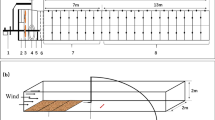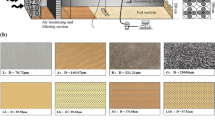Abstract
The present paper describes the anemochorous dispersal of representative diaspores of Asteraceae, Dipsacaceae, and Poaceae from xerothermic grassland communities of Central and Northeastern Germany. For eleven species, potential dispersal distance was determined by fall velocity experiments as well as by taking into account the diaspore flight angle under the influence of an artificially-produced, regularly, and horizontally blowing air stream. The latter is a new and comparatively simple method enabling the implementation of mathematical formulas which describe the potential flight capacity of a diaspore for different wind speeds and exposition heights. Surface structures, shown by a scanning electron microscope, were consulted for the interpretation of results.
Of the species considered, the best fliers are the diaspores of Asteraceae and Melica ciliata (Poaceae) characterized by a plumous pappus or a hairy lemma. The wing-like attachments of the diaspores of the other investigated Poaceae and Dipsacaceae are clearly less efficient for wind dispersal.
The fall rates of the investigated species agree to a great extent with literature data. But a critical comparison of both methods employed shows that fall velocity as a measure of horizontal diaspore flight capacity is only suitable for low wind force < 2 m s-1. With increasing wind force, the dispersal distance of a flying diaspore does not rise in a linear, but rather in an approximately quadratic manner. Thus, in nature, conditions of higher wind forces may be very important for the reachable dispersal distances of well-flying diaspores. This could be of particular significance for nature conservation concepts concerning the vulnerability of species towards isolation within fragmented landscapes.
Similar content being viewed by others
References
Andersen, M. C. 1992. An analysis of variability in seed settling velocities of several wind-dispersed Asteraceae. Am. J. Bot. 79: 1087-1091.
Andersen, M. C. 1993. Diaspore morphology and seed dispersal in several wind dispersed Asteraceae. Am. J. Bot. 80: 487-492.
Augspurger, C. K. & Franson, S. E. 1987. Wind dispersal of artificial fruits varying inmass, area, andmorphology. Ecology 68: 27-42.
Box, E. O. 1996. Plant functional types and climate at the global scale. J. Veg. Sci. 7: 309-320.
Burrows, F. M. 1973. Calculation of the primary trajectories of plumed seeds in steady winds with variable convection. New Phytol. 72: 647-664.
Burrows, F. M. 1986. The aerial motion of seeds, fruits, spores and pollen. Pp. 1-47. In: Murray, D. R. (ed.), Seed dispersal. Academic Press, Sydney.
Bundesamt für Naturschutz 1996. Rote Liste gefährdeter Pflanzen Deutschlands. Schriftenreihe fürVegetationskunde 28, Bonn-Bad Godesberg.
Cody, M. L.& Overton, J. M. 1996. Short-term evolution of reduced dispersal in island plant populations. J. Ecol. 84: 53-61.
Cornelius, R. 1991: Zur Bedeutung populationsbiologischer Forschung für den speziellen Naturschutz. Pp. 298-310. In: Schmid, B. & Stöcklin, J. (eds), Populationsbiologie der Pflanzen. Birkhäuser, Basel.
Dale, V. H. 1989. Wind dispersed seeds and plant recovery on the Mount St. Helens debris avalanche. Can. J. Bot. 67: 1434-1441.
Dansereau, P. & Lems, K. 1957. The grading of dispersal types in plant communities and their ecological significance. Contributions de l’Institut Botanique de l’Université de Montreal 71: 1-52.
Davidse, G. 1986. Fruit dispersal in the Poaceae. Pp. 143-155. In: Soderstrom, T., Hilu, K. W., Campbell, C. S. & Barkworth, M. E. (eds), Grass systematics and evolution. Smithsonian Institution Press, Washington DC.
Dorp, D. van, Hoek, W. P. M. van den & Daleboudt, C. 1996. Seed dispersal capacity of six perennial grassland species measured in a wind tunnel at varying wind speed and height. Can. J. Bot. 74: 1956-1963.
Duval-Jouve, J. 1871. étude anatomique de l’arête des graminées. Bailliêre et fils, Paris.
Ehrendorfer, F., Luftensteiner, H. W. & Petrak, J. 1980. Windkanäle für die Untersuchung anemochorer Verbreitungseinheiten. Plant Syst. Evol. 136: 1-6.
Ellenberg, H. 1996. Vegetation Mitteleuropas mit den Alpen. 5. Ed., Ulmer Verlag, Stuttgart.
Emig, W. & Leins, P. 1994. Ausbreitungsbiologische Untersuchungen in der Gattung CampanulaL. I. Vergleichende Windkanalexperimente zur Samenportionierung bei C. tracheliumL., C. sibiricaL. und C. glomerataL. Botanische Jahrbücher 116: 243-257.
Emig, W. & Leins, P. 1996. Ausbreitungsbiologische Untersuchungen in der Gattung CampanulaL. II. Die Bedeutung der Kapselmorphologie und der Samenausgestaltung f ür das Ausbreitungsverhalten. Botanische Jahrbücher 118: 505-528.
Ernst, W. H. O., Veenendaal, E. M. & Kebakile, M. M. 1992: Possibilities for dispersal in annual and perennial grasses in a savanna in Botswana. Vegetatio 102: 1-11.
Feldman, S. R. & Lewis, J. P. 1990. Output and dispersal of propagules of Carduus acanthoidesL. Weed Res. 30: 161-169.
Frey, W. & Hensen, I. 1995. Lebensstrategien bei Pflanzen: Ein Klassifizierungsvorschlag. Botanische Jahrbücher 117: 187-209.
Geiger, R. 1961. Das Klima der bodennahen Luftschicht. Vieweg & Sohn, Braunschweig.
Gersten, K. 1984. Einführung in die Strömungsmechanik. Vieweg, Braunschweig/Wiesbaden.
Green, D. S. 1980. The terminal velocity and dispersal of spinning samaras. Am. J. Bot. 67: 1218-1224.
Greene, D. F. & Johnson, E. A. 1992. Can the variation in samara mass and terminal velocity on an individual plant affect the distribution of dispersal distances? Am. Nat. 139: 825-838.
Hensen, I. 1997. Life strategy systems of xerothermic grasslands - mechanisms of reproduction and colonization within Stipetum capillataes. l. and Adonido-Brachypodietum pinnati. Feddes Repertorium 108 (5-6): 425-452.
Hodgson, J. G. & Grime, J. P. 1990. The role of dispersal mechanisms, regenerative strategies and seed banks in the vegetation dynamics of the British landscape. Pp. 65-81. In: Bunce, R. G. H. & Howard, D. C. (eds), Species dispersal in agricultural habitats. Belhaven Press, London.
Howe, H. F. & Smallwood, J. 1982. Ecology of seed dispersal. An. Rev. Ecol. Syst. 13: 201-228.
Jackel, A.-K. & Poschlod, P. 1996. Plant strategies on continental dry grassland sites. Verhandlungen der Gesellschaft f ür Ökologie 26: 511-517.
Jedicke, E. 1994. Biotopverbund. Grundlagen und Maßnahmen einer neuen Naturschutzstrategie. 2. Aufl., Ulmer Verlag, Stuttgart.
Kadereit, J. W. & Leins, P. 1988. A wind tunnel experiment on seed dispersal in PapaverL. sects. ArgemonidiumSPACH and RhoeadiumSPACH (Papaveraceae). Flora 181: 189-203.
Korneck, D. & Sukopp, H. 1988: Rote Liste der in der Bundesrepublik Deutschland ausgestorbenen, verschollenen und gefährdeten Farn-und Blütenpflanzen und ihreAuswertung f ür denArten-und Biotopschutz. Schriftenreihe fürVegetationskunde 19, Bonn-Bad Godesberg.
Levin, D. A. & Kerster, H. W. 1974. Gene flow in seed plants. Evol. Biol. 7: 139-220.
Luftensteiner, H. W. 1982. Untersuchungen zur Verbreitungsbiologie von Pflanzengemeinschaften an vier Standorten in Niederösterreich. Bibliotheca Botanica 135: 1-68.
Matlack, G. R. 1987. Diaspore size, shape, and fall behavior in wind dispersed plant species. Am. J. Bot. 74: 1150-1160.
Mayer, V. 1993. Experimentelle Untersuchungen zur Funktion der Fruchtstrukturen bei der Gattungsgruppe Scabiosa(Dipsacaceae). Dissertation, Universität Wien.
Müller-Schneider, P. 1986. Verbreitungsbiologie der Blütenpflanzen Graubündens. Veröffentlichungen des Geobotanischen Institutes der ETH, Stiftung Rübel 85, Zürich.
Okubo, A. & Levin, S. A. 1989. A theoretical framework for data analysis of wind dispersal of seeds and pollen. Ecology 70: 329-338.
Pijl, L. van der 1982. Principles of Dispersal in Higher Plants. Springer Verlag, Berlin.
Pless, H. 1994. Pflanzensoziologische Untersuchungen der kontinentalen Kalkmagerrasen bei Frankfurt/Oder. Veränderung der Vegetation nach 40 Jahren. Verhandlungen des Botanischen Vereins Berlin Brandenburg 127: 117-138.
Rabinowitz, D. & Rapp, J. 1981. Dispersal abilities of seven sparse and common grasses from a Missouri prairie. Am. J. Bot. 68: 616-624.
Reader, R. J. & Buck, J. 1986. Topographic variation in the abundance of Hieracium floribundum: relative importance of differential seed dispersal, seedling establishment, plant survival and reproduction. J. Ecol. 74: 815-822.
Ridley, H. N. 1930. The dispersal of plants throughout the world. Reeve & Co, Ashford.
Rothmaler, W. 1994. Exkursionsflora von Deutschland, Bd. 4. 8. Aufl., Fischer Verlag, Jena.
Sautter, R. 1994. Untersuchungen zur Diasporen und Samenökologie in bedrohten Pflanzengesellschaften sandiger Böden. Dissertationes Botanicae 226: 1-155.
Schmidt, W. 1918. Die Verbreitung von Samen und Blütenstaub durch die Luftbewegungen. Oesterreichische Botanische Zeitschrift 67: 313-328.
Seyfried, L. 1954. Die Bewegungsmechanismen der PulsatillaGranne. Zeitschrift für Botanik 42: 437-457.
Sheldon, J. C. & Burrows, F. M. 1973. The dispersal effectiveness of the achene pappus units of selected Compositae in steady winds with convection. New Phytol. 72: 665-675.
Smith, W. K. 1971. The biological and taxonomic significance of the morphology of the dispersal unit (diaspore), germination patterns and seedling morphology in the Poaceae. Thesis, University of Queensland.
Thompson, K. 1993. Buoyancy in air. Pp. 176-178. In: Hendry, G. A. F.& Grime, J. P. (eds), Methods in comparative plant ecology. Hyman Ltd, London.
Venable, D. L. & Levin, D. A. 1983. Morphological dispersal structures in relation to growth habit in the Compositae. Plant Syst. Evol. 143: 1-16.
Verkaar, H. J., Schenkeveld, A. J. & Klashorst, M. P. van der 1983. The ecology of short lived forbs in chalk grasslands: Dispersal of seeds. New Phytol. 95: 335-344.
Verkaar, H. J. 1990. Corridors as a tool for plant species conservation? Pp. 82-93. In: Bunce, R. G. H. & Howard, D. C. (eds), Species dispersal in agricultural habitats. Belhaven Press, London.
Weiglin, C. 1995. Freilandökologische Untersuchungen und Gewächshausexperimente zur Effizienz hygroskopisch beweglicher Diasporen von Spermatophyten. Bibliotheca Botanica 145: 1-160.
Werner, P. A. 1975. A seed trap for determining patterns of seed deposition in terrestrial plants. Can. J. Bot. 53: 810-813.
Wolfenbarger, D. O. 1959. Dispersion of small organisms. Lloydia 22: 1-106.
Author information
Authors and Affiliations
Rights and permissions
About this article
Cite this article
Hensen, I., Müller, C. Experimental and structural investigations of anemochorous dispersal. Plant Ecology 133, 169–180 (1997). https://doi.org/10.1023/A:1009744518223
Issue Date:
DOI: https://doi.org/10.1023/A:1009744518223




